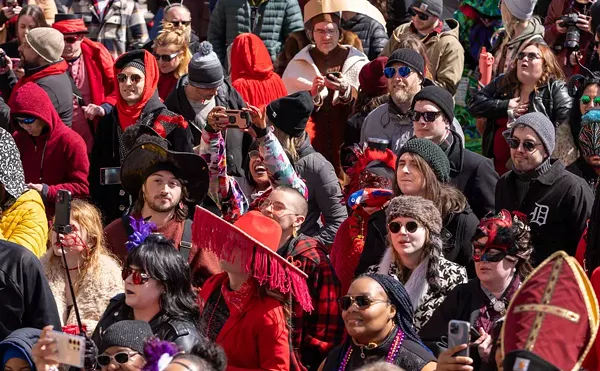The Detroit Institute of Arts has shown plenty of traveling exhibitions organized by other institutions. However, new DIA director Salvador Salort-Pons is explicit about the inimitable flair the institution adds to such exhibitions. "When exhibitions come to Detroit, when they come to the DIA, they change and they are transformed into a DIA vision," he said during a media preview for 30 Americans last week.
To that end, the DIA's ambitious curatorial teams put their own touch on the exhibit, a show that has been presented eight times already by various cultural institutions throughout America since 2008. The show was prepared by the Rubell Foundation, which states that 30 Americans "showcases works by many of the most important African-American artists of the last three decades." And while the art works included in the show are impressive — a seamless collection of both seasoned heavyweights (Carrie Mae Weems, Barkley Hendricks, and Purvis Young) and popular early to mid-career artists (Nina Chanel Abney, Wangechi Mutu, Rashid Johnson, Shanique Smith, Kehinde Wiley, and Iona Rozeal Brown) — it is obvious that it lacks a real curatorial thread. There seems to be a missing connection between the works outside of the obvious: that they are all fantastic works made by African-Americans.
But from an exhibition standpoint, 30 Americans allows a bit of creative freedom for curators to be flexible in presenting ever-evolving themes around the intersections of racial identity, gender, sexuality, colonialism, and class dynamics. And 30 Americans is vast in genre, including abstraction, conceptualism, performance, and new mixed media.
The DIA version is divided into several galleries thematically, with each gallery embodying the ways in which artists have approached their work in response to an exploration of identity. Themes include "representing," "transforming," "confronting," "freestyling," "sampling," and "defying." DIA staff presented works in a way that reconciles the opaque initial curatorial concept, compartmentalizing works in a way that is digestible for viewers.
For instance, the "confronting" gallery includes works that are deeply reflective of the present, even though many of the works were made more than two decades ago. One such installation by Gary Simmons ("Duck, Duck, Noose," 1992) presents a long rope tied in a noose hanging about six feet from the ceiling. Nine small white hoods surround the noose with cut out slits for eyes, placed neatly on wooden chairs. The scene should be recognizable to many who are familiar with the Ku Klux Klan and American history. However, what is subtle is the small scale of the hoods and role of the chairs. "Duck, Duck, Noose" is a play on the childhood game Duck, Duck, Goose, where the small hoods represent the innocence of children inheriting the trope of racism as a part of a traditional drill, just like the game.
In this same gallery, a photograph by Hank Willis Thomas ("Priceless," 2004) uses taglines from the popular MasterCard commercials from the 1990s to address the serious matter of frivolous gun violence in America. The photograph depicts a melancholy scene of individuals in mourning, fixated on an object not in the frame. A host of statements are listed on the photogram: the price of a 9mm pistol, the cost of a gold chain, and at the bottom: "Picking the perfect casket for your son: priceless." With over 1,100 black bodies killed by U.S enforcement so far this year alone, both Simmons' and Thomas' work makes light of the fact that today, carrying the black identity can still be lethal.
Conversely, the African-American identity can also be stylish — often paired with an inimitable bravado and an unapologetic resistance to what is expected by mainstream society. This conception is embodied widely throughout the exhibition. One of the first pieces presented to viewers is a work by Mickalene Thomas in the "Defying" gallery ("Hotter than July," 2005). The mixed-media painting depicts a reclining black woman, dressed in a short skirt and an unbuttoned blouse, her breasts visible. The figure's position illustrates a mood of not only comfort but also an unrepentant demeanor.
As I sifted through the exhibition in about an hour's time, the works made me feel emotions on a scale from pride to pain — the most potent dichotomy of experiences many African-Americans may feel by living in the USA. At the exit of the exhibition are two photo booths. In them, exhibition organizers encourage visitors to answer a host of questions on self-identification through an interactive iPad-driven app.
Specifically, the prompt begins with the statement "I am more than my..." Visitors are expected to fill in the blank with typical identification moniker such as race, gender, and sexuality. The second part of the interactive feature allows visitors to choose from a host of adjectives that best describe their personality. The experience ends with a selfie session, where visitors present their most true self-identification using the adjective they have chosen. The selfies are then displayed on a grid screen outside of the exhibition entrance, allowing for visitors to not only interact with the show but become a part of it as well. The DIA also encourages visitors to reflect their experiences through social media using the hashtag "#30plusUs," an insightful tagline allowing exhibiting attendees, African-American and otherwise, to participate in the often layered dialogue on identity.
30 Americans has served as a way for many traditional cultural institutions to tackle issues around race and other taboo identities in a proactive way. This ninth iteration of the exhibit signifies the need to address racial identities head on, and with much sincerity. Hopefully, this exploration into American individualities will spark more ethnically conscious exhibitions within the DIA and other American institutions.
Taylor Renee Aldridge is co-editor of Arts.Black, an online arts criticism magazine.
30 Americans is on view until Jan. 18 at the Detroit Institute of Arts; 5200 Woodward Ave., Detroit; 313-833-7900; dia.org; tickets are $14 for adults, $10 for Wayne, Oakland and Macomb county residents, $7 for ages 6–17, $5 for Wayne, Oakland and Macomb county residents ages 6–17, and free for DIA members.






